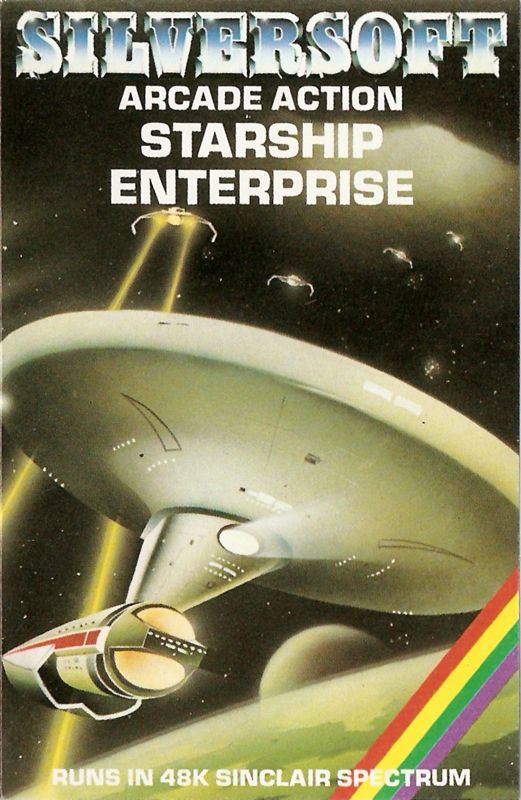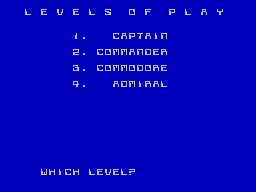Retro Replay Review
Gameplay
Starship Enterprise delivers a deeply strategic experience that puts you at the heart of command. Rather than trading laser blasts in a frantic arcade shoot-‘em-up, you’ll navigate a rich array of shipboard systems—accessing navigation computers, long-range scanners, weapons controls and real-time damage reports as distinct in-game screens. Each decision feels weighty, whether you’re plotting your warp course through adjacent sectors, pinpointing hidden Romulan warbirds on your sensor grid, or rerouting power from shields to impulse engines.
(HEY YOU!! We hope you enjoy! We try not to run ads. So basically, this is a very expensive hobby running this site. Please consider joining us for updates, forums, and more. Network w/ us to make some cash or friends while retro gaming, and you can win some free retro games for posting. Okay, carry on 👍)
The core loop centers on exploration and cat-and-mouse engagements. You begin in one of 64 quadrants, each subdivided into 64 sectors, and the Romulan vessels lie in wait along warp lanes and asteroid fields. Discovering and pursuing these threats demands careful energy management: overusing phasers burns through reserves quickly, while overreliance on photon torpedoes can leave your ship vulnerable in later encounters. The result is a satisfying push-and-pull tension that rewards thoughtful planning over button-mashing reflexes.
Replayability is a standout feature. Every new game randomly generates the layout of stars, bases, and Romulan incursions, ensuring that no two missions feel identical. You’ll also select from multiple difficulty settings that adjust enemy aggressiveness, sensor fidelity, and the starting condition of your vessel. Whether you’re a newcomer craving a gentle introduction to interstellar command or a veteran seeking a brutal mental gauntlet, the gameplay scales to match.
Graphics
Visually, Starship Enterprise leans into a minimalist, functional aesthetic. The star maps and sector displays use simple vector graphics with crisp, glowing lines to denote ship positions, spatial hazards, and warp currents. While it doesn’t boast photo-realistic textures, the clean interface conveys crucial tactical information clearly, and the occasional flicker of vector-based explosions carries a nostalgic charm.
Each shipboard interface screen is styled to resemble a futuristic control panel. The navigation console presents a wireframe starfield backed by a monochrome grid, while the weapons display highlights target locks and torpedo counts in bright accent colors. Animations are brief but effective—phaser bursts and torpedo launches are shown as fast, abstract streaks that keep the flow of gameplay brisk.
Though dated compared to modern AAA titles, the graphics serve the game’s emphasis on cerebral strategy rather than visual spectacle. If you appreciate retro sci-fi flair and value an uncluttered presentation that foregrounds tactical clarity, you’ll find the art direction both functional and evocative of classic space-odyssey terminals.
Story
The narrative thrust of Starship Enterprise is stark and immediate: the Romulan Empire has launched a devastating assault, nearly annihilating the Federation’s fleet. You alone remain in command of the legendary starship, charged with a sole objective—hunt down and eliminate every Romulan warship before they can strike again. This high-stakes premise sets a relentless pace and lends weight to every decision you make.
Storytelling unfolds primarily through mission briefings and in-game text reports rather than cinematic cutscenes. Status updates flash across your communications console, relaying sensor readings, distress calls from surviving outposts, and intercepted Romulan transmissions. Though economical, this approach draws you into the role of a starship captain on the brink of enemy territory, improvising under pressure with only your wits and your vessel’s systems.
While the overall plot follows a straightforward “last-ship-standing” arc, the randomized galaxy layout injects subtle narrative variety. No two playthroughs reveal the Romulan disposition in the same order, and occasional encounters with Federation wreckage or isolated patrol craft offer brief, emergent storytelling moments. As you carve your path through the stars, the saga of survival and retribution becomes uniquely yours.
Overall Experience
Starship Enterprise stands out as a measured, thought-provoking take on space combat and exploration. Its emphasis on multi-screen system management and strategic resource juggling makes for a cerebral cruise through hostile territory. You’ll find plenty of satisfaction in outmaneuvering enemy vessels using careful warp jumps, sensor triangulation and judicious power redistribution.
There is a learning curve: mastering each console’s readouts and understanding how best to deploy phasers versus torpedoes requires patience. Similarly, the interface can feel menu-heavy to players accustomed to point-and-click convenience. Yet overcoming these initial hurdles only deepens the sense of accomplishment when you triangulate a Romulan dreadnought in the void and watch it vanish in a pulse of video-game pyrotechnics.
For fans of strategic sci-fi with strong replay value, Starship Enterprise remains a compelling voyage. It may not flash with photo-realistic vistas, but its streamlined graphics and robust randomization engine keep each mission fresh. If you’re looking to captain the Federation’s last hope against an implacable enemy—and savor every tactical choice along the way—this game charts a star-filled course worth embarking on.
 Retro Replay Retro Replay gaming reviews, news, emulation, geek stuff and more!
Retro Replay Retro Replay gaming reviews, news, emulation, geek stuff and more!









Reviews
There are no reviews yet.